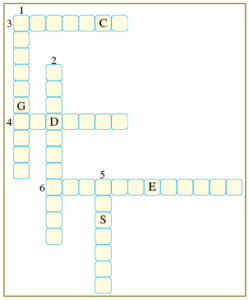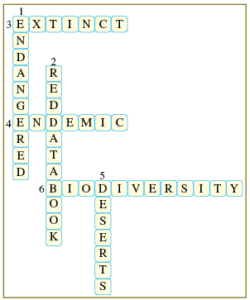Table of Contents
NCERT Solutions for Class 8 Science Chapter 7: Conservation of Plants and Animals is a crucial topic for students. To assist students in understanding the concepts with ease, a solution PDF is provided here. These solutions aim to clear doubts and explain the chapter in a simple and engaging way. Prepared by subject experts, they align perfectly with the latest CBSE syllabus.
This NCERT Solution set includes not only answers from the textbook but also conservation of plants and animals class 8 questions and answers, exemplar problems, worksheets, HOTS, MCQs, and short answer questions. These comprehensive solutions act as a valuable resource to support students in their exam preparations.
Using Infinity Learn NCERT Solutions allows Class 8 students to develop a strong conceptual understanding of each topic. Regular practice with these solutions will enable students to confidently prepare for their exams and perform well.
NCERT Solutions for Class 8 Science Conservation of Plants And Animals Question Answer
1. Fill in the blanks
a) A place where animals are protected in their natural habitat is called
b) Species found only in a particular area are known as _________ species.
c) Migratory birds fly to faraway places because of _________ changes.
Ans. a) wildlife sanctuary
b) Endemic
c) climatic

2. Differentiate between the following:
a) Wildlife sanctuary and biosphere reserve
b) Zoo and wildlife sanctuary
c) Endangered and extinct species
d) Flora and fauna
Ans. a) Wildlife sanctuary and biosphere reserve
| WILDLIFE SANCTUARY | BIOSPHERE RESERVE |
| An area that provides protection and suitable living conditions to wild animals is called a wildlife sanctuary.
|
An area that is meant for the conservation of biodiversity of a particular area is called a Biosphere reserve. |
| In this, killing (poaching) or capturing animals is prohibited.
Eg: Chambal wildlife sanctuary, Gharial wildlife sanctuary, etc. |
This helps to maintain the biodiversity and culture of that area.
Eg: Pachmarhi biosphere reserve
|
b) Zoo and wildlife sanctuary
| Zoo | Wildlife sanctuary |
| It is a place where animals are protected in artificial habitats for public view. | It is a place that provides protection and suitable living conditions to wild animals. |
| It is an artificial habitat.
Eg: Indira Gandhi zoological park, Visakhapatnam. |
It conserves the natural habitat of animals.
Eg: Dinosaurs |
c) Endangered and extinct species
| Endangered Species | Extinct species |
| The species which are facing the danger of extinction are called Endangered species. Eg: Bengal tiger. | The species which do not exist on the earth are called extinct species.
Eg: Dinosaurs |
d) Flora and fauna
| Flora | Fauna |
| The plants that are found in a particular area are called Flora.
Eg: Sal, teak, mango, etc. are the flora of the Pachmarhi biosphere reserve. |
The animals that are found in a particular area are called Fauna.
Eg: Leopard, Wolf, blue ball, etc. are the fauna of the Pachmarhi biosphere reserve. |
3. Discuss the effects of deforestation on the following.
a) Wild animals
b) Environment
c) Villages (Rural areas)
d) Cities (Urban areas)
e) Earth
f) The next generation
Ans. a) Effects of deforestation on Wild animals :
- Forests are the habitats of many wild animals.
- As a result of deforestation wild animals lose their habitat and may migrate to other places or may become extinct.
b) Effects of deforestation on the Environment :
- The level of carbon dioxide in the atmosphere will be increased and this causes global warming.
- Disturbs the water cycle.
- Thus, deforestation disturbs the ecological balance in nature.
c) Effects of deforestation on Villages (Rural areas) :
- Rainfall will be reduced. This leads to scarcity of water for drinking and
- So that agricultural productivity will be decreased.
- Effects of deforestation on Cities (Urban areas) :
- Pollution and temperature in the cities will be increased due to deforestation.
e) Effects of deforestation on Earth :
- The temperature on the surface of the earth increases and leads to global
- It decreases the water holding capacity and infiltration rate of the soil.
- The properties of the soil like nutrient content, texture, etc. are also changed.
- Promotes soil erosion.
- Deforestation leads to desertification.
f) Effects of deforestation on the next generation :
- Deforestation causes global warming, soil erosion, greenhouse effect, drought, floods, and many other global problems.
- The next generation may not get a cleaner and safer environment to live in.
4. What will happen if
a) we go on cutting trees.
b) the habitat of an animal is disturbed.
c) the top layer of soil is exposed.
Ans. a) If we go on cutting trees :
- we will not get fresh air.
- results in natural calamities like floods, droughts, etc.
- global temperature will be increased.
- the water cycle will be disturbed.
b) If the habitat of an animal is disturbed :
the animal will lose its natural habitat and finally, it may be endangered or __extinct.
c) If the top layer of soil is exposed :
- it decreases the fertility and water holding capacity of the soil.
- this results in a decrease in agriculture productivity.
5. Answer in brief
a) Why should we conserve biodiversity?
b) Protected forests are also not completely safe for wild animals. Why?
c) Some tribals depend on the jungle. How?
d) What are the causes and consequences of deforestation?
e) What is Red Data Book?
f) What do you understand by the term migration?
Ans.
- We should conserve biodiversity to maintain balance in nature.
- Even protected forests are not safe for wild animals because people living in the neighborhood encroach upon them and destroy them.
c) Tribals depend on the jungle for :
- food items like seed grains, fruits, vegetables, and other products like honey, meat, etc.
- fodder for their animals.
- firewood and for clothing (animal skins, leaves, etc.).
d) Causes of Deforestation :
- Procuring land for cultivation.
- Building houses and factories.
- Making furniture or using wood as fuel.
- Forest fires and severe droughts.
Consequences of Deforestation :
- Upsets the natural balance between animals and plants.
- Decreases the rainfall.
- Decreases the amount of underground water.
- Increases soil erosion.
- Increases the amount of CO2 in the atmosphere.
- Causes floods, droughts, global warming, etc.
- The book which contains a record of endangered species is called Red Data
- The phenomenon of movement of a species from its own habitat to some other habitat in a particular time period every year for a specific purpose like breeding is called migration.
6. In order to meet the ever-increasing demand in factories and for shelter, trees are being continually cut. Is it justified to cut trees for such projects? Discuss and prepare a brief report.
A. If trees are being cut continuously for factories and shelter :
- many animals, birds and other organisms lose their shelters.
- this upsets the balance between plants and animals (causes ecological imbalance).
- this also causes many natural calamities.
Hence, it is not justified to cut trees to meet the ever-increasing demands of the human population.
Also Read: NCERT Textbooks
7. How can you contribute to the maintenance of the green wealth of your locality? Make a list of actions to be taken by you.
A. i) We can grow more and more plants in our locality.
ii) We can protect them and provide water to them.
iii) All the residents should be educated about the benefits of growing trees and the harmful effects of cutting the trees.
8. Explain how deforestation leads to reduced rainfall.
Ans.
- Due to deforestation, the amount of CO2 in the atmosphere will be increased.
- Carbon dioxide traps the heat rays reflected by the earth, the amount of heat (temperature) will be increased on the earth’s surface.
- This causes global warming and disturbs the water cycle.
- As a result the amount of rainfall is reduced.
9. Why should the paper be saved? Prepare a list of ways by which you can save paper.
Ans. We should save paper to reduce deforestation and to conserve the trees on the earth (as the paper is made from trees).
Ways to save paper :
- By creating awareness about the importance of paper.
- Reuse and recycle.
- Reduce the usage of paper.
10. Complete the word puzzle :

Down :
Species on the verge of extinction.
A book carrying information about endangered species.
A consequence of deforestation.
Across :
Species that have vanished.
Species are found only in a particular habitat.
Variety of plants, animals, and microorganisms found in an area.
Ans.

NCERT Solutions for Class 8 Science Chapter 7 – Conservation of Plants and Animals (Free PDF Download)
The subjects and sub-topics in this chapter of the science curriculum for 8th grade, ‘Conservation of Plants and Animals,’ can help you study more efficiently. NCERT Solutions for class 8 science chapter 7 contains the relevant question-answers. As a result, students should go over the NCERT solutions in order to get better grades on the exam.
Class 8 Science Chapter 7 Problem questions and NCERT Solutions
The seventh chapter of class 8 NCERT science solutions includes both subjective and objective questions. There are a few key questions and answers that are presented in the NCERT solutions for class 8 science chapter 7. INFINITY LEARN website provides access to this information for free.
The Effects and Causes of Deforestation
Existing plants and animals on the planet are critical to humanity’s survival and well-being. It is also recognized as one of the most serious threats to humanity.
Deforestation is the process of clearing and removing forests in order to utilize the land for other uses. Other typical activities include the ones listed below.
- Obtaining agricultural land.
- Using wood as a source of energy and resources
Other natural causes include, for example,
Forest fires and droughts are two of the most common natural disasters.
Deforestation has the following consequences:
- Erosion of the soil.
- The water cycle has been disrupted.
- Global warming is causing climate change.
Related Information
- NCERT Solutions for Class 8 Maths
- NCERT Solutions for Class 8 Social Science
- NCERT Solutions for Class 8 English
- NCERT Books for Class 8
- NCERT Exemplar for Class 8 Maths
- NCERT Exemplar for Class 8 Science
Wildlife Sanctuary
This is a zone where animal habitats and their surroundings are safe from harm and disruption. Capturing and killing animals is absolutely prohibited in these areas. A wildlife sanctuary’s main goal is to offer a comfortable and safe environment for the animals. The authorities make these areas ideal for animals while also ensuring their safety. In the NCERT solutions for class 8 science chapter 7, the answer includes an explanation.
Biosphere Reserve
It is a vast protected area dedicated to biodiversity and cultural preservation. A biosphere reserve is a protected area where endangered plant and animal species can be found in their natural habitat. In class 8 science chapter 7, there is a detailed discussion of the biosphere reserve.
Flora and Fauna
NCERT answers for class 8 science chapter 7 Conservation of Plants and Animals include a chart that explains this topic. Flora is a term used to describe the collective plant life that existed in a certain location at a given time. The number of animals living in a specific area at a specific time period is referred to as fauna. Plants and animals are referred to as flora and fauna in general.
Endangered Species
The difference between endangered and extinct species is discussed in NCERT Class 8 science chapter 7. Endangered species are those that are most likely to go extinct in the near future, either globally or in a specific region.
Species that have become extinct
Extinct species are those that no longer exist after having existed in the past. Extinction is often defined as the death of the last individual of a species. The difference between endangered and extinct species is explained in NCERT solutions for class 8 science chapter 7 answer 2(c).
FAQs on NCERT Class 8 Science Chapter 7
What is conservation of plants and animals for Class 8?
Conservation of plants and animals for Class 8 refers to the study of preserving and protecting the diversity of plant and animal species on Earth to maintain ecological balance and sustainability.
What is conservation class 8 answer?
In Class 8, conservation refers to the practice of safeguarding and managing natural resources, including plants and animals, to ensure their survival and the well-being of our planet.
What is conservation class 8 science?
In Class 8 science, conservation involves understanding and applying strategies to protect and preserve the biodiversity of plants and animals, maintaining the ecological equilibrium.
How can you conserve plants and animals - write 5 points?
Conservation of plants and animals can be achieved by: Protecting natural habitats from destruction. Implementing laws against poaching and illegal logging. Promoting responsible wildlife tourism. Cultivating native plants and creating wildlife-friendly gardens. Raising awareness through education and community participation.
What is the name of Chapter 7 Class 8 science?
The name of Chapter 7 in Class 8 science varies depending on the specific curriculum or textbook being used. Please refer to your specific textbook or syllabus for the chapter title.









